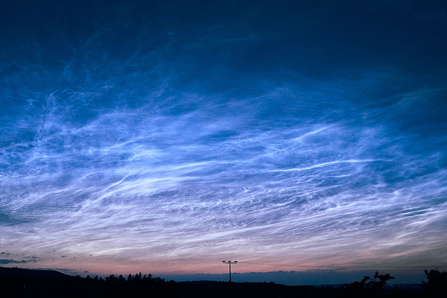Sun
On the morning of June 10th there will be an eclipse of the Sun. From Southern England it will be a partial eclipse, at most only 20% of the Suns disk will be covered.
First DO NOT LOOK AT THE SUN WITHOUT PROTECTION! I can not emphasise strongly enough that if you do you will be blinded.
So how can you see the eclipse? It will be streamed by various groups online. If you want to see it yourself a simple way is to take two pieces of cardboard! One should have a white or pale side, the other put a small hole in the middle of it. You can use anything sharpish, even the tip of a ballpoint pen will do, but keep the hole small.
Stand with the Sun to your left so you are sideways on to it (you can do this from the right if you wish). Hold the white card in your right hand and with your left hold the card with the hole in front of it a couple of feet away. What you have just built is a simple pin hole camera and you will have a small image of the Sun projected onto the white card.
But nature is full of natural pin hole cameras! If you stand in the dappled Sunlight under a tree each spot of light is a miniature image of the Sun projected by the tiny gaps between the leaves. Normally you wouldn’t pay much attention to this as the spots are round like the Sun is in the Sky. But if you look on the morning of the 10th you will see that by about quarter past eleven there will be a piece missing from each spot of light.
The details: The Moon will first start to pass over the Sun at 10:08, maximum is at 11:13 and it leaves the Sun at 12:26. Let us hope for a clear sky.
Cloud
From late May through to late July in Southern England we don’t ever have a true night sky. Because the Sun isn’t that far below the horizon it is always twilight, although in light polluted Southern England it doesn’t make much difference to how dark the sky looks.
But it does light up things in the upper atmosphere (from where the Sun has not set). Satellites, for instance, are one of these objects which you can see more of in summer.
Rarer are noctilucent clouds. These thin wispy clouds appear a pale blue in colour. They are the highest clouds in our atmosphere at about 80 km high and so are still lit by the Sun even though it is dark here on the ground. They are not often seen, but when they are they will be in the Northern part of the sky. They are quite difficult to spot as they are not very bright but the pale blue colour is distinctive. They are only visible over the summer months.
They were first seen in 1885 and sightings of them are getting more common, but that might be because people are looking for them rather than that they happen more often.
An example of noctilucent clouds:


